Influenza
Influenza, commonly known as the flu, is an infectious disease caused by influenza viruses. It is characterised by symptoms ranging from mild to severe, including fever, runny nose, sore throat, muscle pain, headache, coughing, and fatigue. The symptoms typically appear one to four days after exposure and last for about two to eight days.

Signs and Symptoms

The onset of influenza symptoms is sudden and includes fever, chills, headaches, muscle pain, malaise, loss of appetite, lack of energy, and confusion. Respiratory symptoms such as a dry cough, sore throat, and a stuffy or runny nose also occur. Gastrointestinal symptoms, including nausea, vomiting, and diarrhoea, are common in children. Severe illness may progress to pneumonia, either from the primary viral infection or a secondary bacterial infection.
Virology

Influenza viruses are divided into four types: A, B, C, and D. Influenza A and B cause seasonal epidemics, while C causes mild infections, primarily in children, and D is found in cattle and pigs. The virus spreads through respiratory droplets from coughing and sneezing, as well as contaminated surfaces.
Transmission
Infected individuals can transmit influenza through breathing, talking, coughing, and sneezing, which spread respiratory droplets and aerosols into the air. The virus can also survive on surfaces, leading to transmission through contact.
Diagnosis

Diagnosis is often based on symptoms but confirmed with laboratory tests such as viral cultures, antibody and antigen tests, and nucleic acid-based tests like RT-PCR. Samples for testing are typically collected via nasal and throat swabs.
Treatment
Treatment includes supportive measures such as anti-fever medications, adequate fluid intake, and rest. Antiviral drugs like oseltamivir and zanamivir are used to treat severe cases, especially in immunocompromised patients. These antivirals are most effective when started within 48 hours of symptom onset.
Prevention
Annual vaccination is the primary prevention method, with vaccines available in trivalent or quadrivalent forms. Vaccines are either inactivated or live attenuated and are recommended for high-risk groups such as young children, the elderly, and those with chronic health conditions. Hand hygiene, covering one's mouth and nose when coughing or sneezing, and avoiding contact with infected individuals are also important preventive measures.
Prognosis
In healthy individuals, influenza is usually self-limiting, with symptoms lasting 2–8 days. Complications and mortality are more common in high-risk populations, often leading to pneumonia or acute respiratory distress syndrome. Fatigue and malaise may persist for several weeks after recovery.
Epidemiology

Influenza causes seasonal epidemics and occasional pandemics. Annually, it infects 5–15% of the global population, causing 3–5 million severe cases and approximately 290,000–650,000 deaths due to respiratory illness. The disease disproportionately affects children, the elderly, and immunocompromised individuals.

In temperate regions, influenza peaks during winter, while in tropical regions, it can occur year-round. The virus evolves rapidly, necessitating annual updates to vaccines.
Self-assessment MCQs (single best answer)
What is the primary cause of influenza?
Which of the following symptoms are most common in influenza?
Which types of influenza viruses cause seasonal epidemics?
How is influenza primarily transmitted?
What is the most effective time to start antiviral treatment for influenza?
What is the primary method of preventing influenza?
Which population groups are at higher risk of complications from influenza?
Which diagnostic method is NOT commonly used for confirming influenza?
In which regions does influenza occur year-round?
What is a common complication of severe influenza?
Dentaljuce
Dentaljuce provides Enhanced Continuing Professional Development (CPD) with GDC-approved Certificates for dental professionals worldwide.
Founded in 2009 by the award-winning Masters team from the School of Dentistry at the University of Birmingham, Dentaljuce has established itself as the leading platform for online CPD.
With over 100 high-quality online courses available for a single annual membership fee, Dentaljuce offers comprehensive e-learning designed for busy dental professionals.
The courses cover a complete range of topics, from clinical skills to patient communication, and are suitable for dentists, nurses, hygienists, therapists, students, and practice managers.
Dentaljuce features Dr. Aiden, a dentally trained AI-powered personal tutor available 24/7 to assist with queries and provide guidance through complex topics, enhancing the learning experience.
Check out our range of courses, or sign up now!


